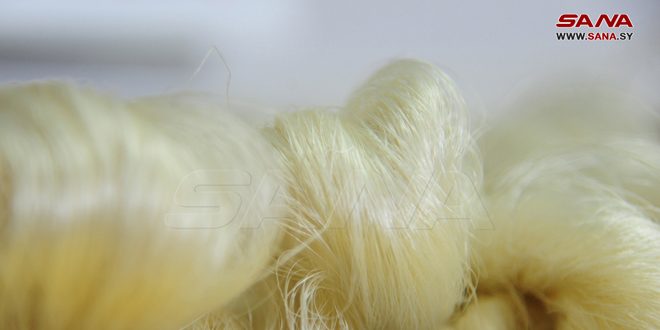The history of silk dates back to the third millennium BC, when the oldest piece of silk was discovered in China. Its use was monopolized by the ruling class, merchants and clerics, until it spread outside the country through the trade route known as the “Silk Road”.
A member of the teaching staff at the University of Damascus and a member of the silk committee at the International Silk Center Lyon, France, Dr. Eng. Hisham Al-Riz, noted that Europe followed a scientific and economic approach to developing silk when this treasure reached it. The research centers assumed the task of developing breeding and production by devising improved types of berries and strains of silkworms and the development of tools and requirements of education and work.
Dr. Al-Riz told a SANA reporter: “Because of the favorable conditions in Syria for silkworm breeding and the cultivation of blueberry trees, and its presence as a land meeting point between the (the Silk Road) trade caravans and the (European) maritime ones, Syria was considered one of the ancient countries historically in breeding and manufacturing silk since the first century AD until the twelfth century AD.
Dr. Al-Riz added: “Syria was the main center for the silk industry and trade, and it outperformed European and Asian products until the middle of the twentieth century in this field for many centuries. It was famous for making brocade cloth.
Dr. Al-Riz pointed out that women in Syria and other Arab countries in Lebanon, Egypt, Libya and Algeria constituted about 90 percent of the workforce in the field of the silk sector. They dealt with this industry eagerly and spontaneously.
For his part, Iyad Muhammad, Director of Plant Protection at the Ministry of Agriculture and Agrarian Reform, pointed out that silkworm breeding and the manufacture of its products declined in Syria in the twentieth century, due to the cutting of blueberry trees and breeding for one season, dependence on importing eggs and the traditional method, difficulty in marketing and high costs, in addition to competition from other crops.
Muhammad added: “The breeding of silkworms was concentrated in the governorates of Lattakia, Tartous, Hama and Homs, and its manufacture was concentrated in Damascus and Aleppo. In 1856 AD, the production of silk cocoons reached about 8,000 tons, of which 5,000 tons were for export, while in 1913 AD, the production reached 6,000 tons of cocoons.”
Muhammad said: ” In 1943, Legislative Decree No. 30 was issued regulating the profession of silk industry and silkworm breeding, and the silk factory in the Draikish area was affiliated with the Ministry of Agriculture between 1963 and 1980.”
Muhammad continued: “In the year 2000, the Arab Center (ACSAD) carried out a field study on the silk sector in Syria and the development of its production. The bee and silk project was established in the Ministry of Agriculture in 2003, and in 2004 a decision was issued by the Ministry of Industry that includes standard specifications for silk and marketing cocoons.”
Muhammad indicated that the approval to join the membership of the International Silk Center, which is based in Lyon, France, took place in 2007, and in 2016 the Ministry of Agriculture launched a national project to revive silkworm breeding.
For his part, Director of Forestry at the Ministry of Agriculture, Dr. Ali Thabet, said: “Based on promoting the concept of afforestation according to agro-forestry systems, and with the aim of benefiting from its fruits and raising silkworms on its leaves, 5 blueberry seedlings are distributed free of charge to each family as part of the activities of a distribution campaign launched by the ministry this year.”
Inas Abdulkareem

